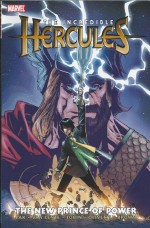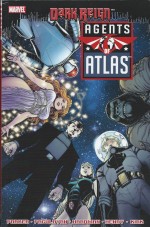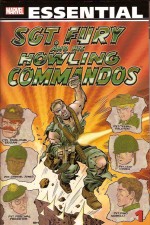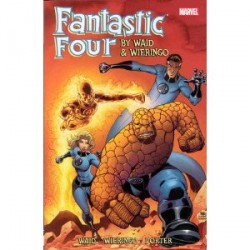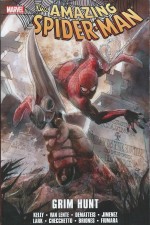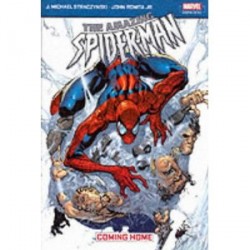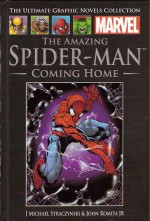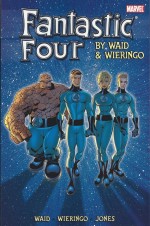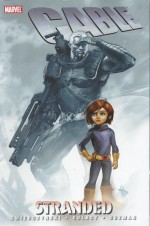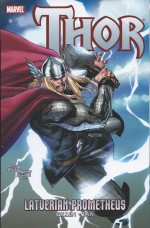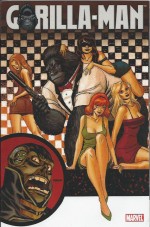
By Jeff Parker, Jason Aaron, Stan Lee, Larry Lieber, Giancarlo Caracuzzo, Jack Kirby, Bob Powell, Bob Q. Sale & various (Marvel)
ISBN: 978-0-7851-4911-8
Apes have long fascinated comics audiences, and although Marvel never reached the giddy heights of DC’s slavish and ubiquitous exploitation of the Anthropoid X-factor, the House of Ideas also dabbled in monkey madness over its long years of existence.
This slim mixed-bag of a tome gathers newer adventures of happily hirsute hero Ken Hale – gregarious Gorilla-Man of resurrected 1950s super-group pioneers Agents of Atlas – culled from the eponymous 2010 three-issue miniseries and supplemented with pertinent material from Avengers vs. Atlas #4, X-Men First Class #8, plus assorted earlier interpretations of Ape Avengers culled from the company’s back catalogue of anthology horror and mystery titles: specifically Men’s Adventures #26, Tales to Astonish #28 and 30 and Weird Wonder Tales #7.
What you need to know: the Agents of Atlas comprise rejuvenated 1950s super-spy Jimmy Woo and similarly vintaged superhuman crusaders Namora (Sub-Mariner’s cousin), spurious love-goddess Venus, a deeply disturbing unhuman Marvel Boy from Uranus, primitive wonder-robot M11 and the aforementioned anthropoid avenger. As the Atlas Foundation, these veterans surreptitiously fight for justice and a free world as the nominal leaders of a clandestine crime-cult which still thinks it’s being patiently guided towards the overthrow of all governments. The real power behind the organisation however is a terrible mystical dragon named Lao…
The modern mainstream saga concentrates on ‘Ken Hale, the Gorilla-Man: The Serpent and the Hawk’ – from Jeff Parker & Giancarlo Caracuzzo – by exploring the anthropoid adventurer’s origins following a particularly bizarre battle against spidery cyborg Borgia Omega.
In search of another action-packed mission, Hale spots a familiar face on an Atlas “wanted poster†and heads for Africa, flashbacking his past for us along the way.
Missouri, 1930 and a visiting big-shot spots something in a poor orphan kid holding his own against seven bigger boys who picked the wrong dirt-grubber to bully…
J. Avery Wolward was a millionaire man-of-intrigue with interests all over the globe and for the next decade little Kenny became his companion and partner in a series of non-stop escapades that would make Indiana Jones green with envy. Ken learned a lot about life and loyalty, eventually discovering that Wolward owed much of his success to a mystical snake walking stick.
Now that cane is in the hands of an African crime-lord calling himself Mustafa Kazun who is well on the way to stealing an entire country and building an empire of blood…
Each issue of the miniseries was augmented by comedic faux email conversations between Hale and his social networking fans, which delightfully act here to buffer the transitions between modern menace and reprinted monkey mystery tales.
The first of these is ‘It Walks Erect!’ taken from 1974’s Weird Wonder Tales #7 (which itself rescued the yarn from pre-Comics Code Mystery Tales #21(September 1954).
The story (by an unknown author and illustrated by the brilliant Bob Powell) concerns compulsive rogue surgeon Arthur Nagan whose obsession with brain transplants took a decidedly outré turn when his gorilla test-subjects rebelled and wreaked a darkly ironic revenge upon him…
Slavish fanboys like me might remember Nagan as the eventual leader of arcane villain alliance The Headmen… but probably not…
Hale’s origin resumes as he and local agent Ji Banda are attacked by Kazun’s enslaved army, but that doesn’t stop the simian superman describing how a clash with Wolward’s arch-rival Bastoc to recover an ancient bird talisman in Polynesia led the then-full-grown soldier-of-fortune to split with his mentor and enlist in the US military just before Pearl Harbor…
By the time the war ended Wolward was gone and the magnate’s daughter Lily had inherited both the family business and the walking stick…
After another message-board break, the classic ‘I Am the Gorilla Man’ (from Tales to Astonish #28 February 1962, by Stan Lee, Larry Lieber, Jack Kirby & Dick Ayers) revealed how criminal genius Franz Radzik developed a mind-swapping process so that he could use a mighty ape’s body to commit robberies.
Sadly the big brain forgot that, with its personality in a human body, the anthropoid might have its own agenda and plenty of opportunity…
The conclusion of ‘The Serpent and the Hawk’ then sees Hale link up with a tribe of gorillas to overturn Kazun’s schemes and unlock the secret of the stick, even as his mind is firmly replaying his bad marriage to Lily, subsequent decline into drunken dissolution, recruitment by the arcane Mr. Lao, and eventual confrontation with the previous Immortal Gorilla-Man…
The role is an inherited one and a curse. To kill the undying Gorilla is to become him, and the previous victim had by this time had enough. Even after Hale refused to end the creature’s torment, it relentlessly followed him until it could trick the drunken mercenary into taking on the curse…
However, after linking up with 1950s heroes like Jimmy Woo and Venus, Hale found it truly liberating grew to accept his new status…
Thus when Kazun’s true identity is revealed and the weary adventurer offered a permanent if Faustian cure, Gorilla-Man makes the only choice a true champion can…
A final text presentation precedes Lee, Lieber, Kirby & Ayers’ ‘The Return of the Gorilla Man’ (from Tales to Astonish #30, April 1962) wherein Radzik, still locked in a gorilla’s body, escapes captivity and frantically attempts to prove to scientists how smart he is.
Big mistake…
Further insight into Hale is provided by ‘My Dinner with Gorilla-Man’ by Jason Aaron & Caracuzzo from Avengers vs. Atlas #4, as a desperate man with nothing to lose hunts down the ageless anthropoid, intent on fulfilling the ageless equation: “Kill the Gorilla and live foreverâ€â€¦
This is followed by a glorious romp from X-Men: First Class #8. ‘Treasure Hunters’ by Jeff Parker & Roger Cruz finds the debut generation of Xavier’s mutants – Cyclops, Angel, Beast, Iceman and Marvel Girl – hunting for their missing teacher in the Congo. Along the way they encounter a talking gorilla who becomes their guide, inadvertently pulling reclusive hermit Hale out of a decades-long funk…
This collection concludes with the seminal supernatural suspense thriller which first introduced ‘Gorilla Man’ to the world. Again by an anonymous writer (possibly Hank Chapman) and illustrated by the wonderful Robert (“Bob Qâ€) Sale, this evocative chiller from Men’s Adventures #26 (March 1954) offers a far grittier take on the origin as a man terrified of dying and plagued by nightmares of fighting apes hears a crazy legend and heads for Kenya and an inescapable, horrific destiny…
Also included is a selection of 21st century covers by Dave Johnson, Leonard Kirk, Dave McCaig, Gabrielle Dell’Otto, Humberto Ramos, Edgar Delgado & Marko Djurdjevic, with the vintage frontages represented by Jack Kirby, Larry Lieber and Dick Ayers.
Outrageous, over the top and never taking itself seriously, this is a riot of hairy scary fun-filled frolics and a perfect antidote to po-faced Costumed Dramas.
© 1954, 2007, 2010 Marvel Characters, Inc. All rights reserved.

